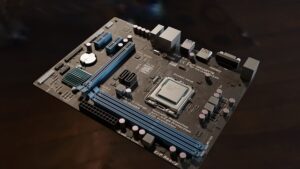A motherboard is the most crucial part of a computer. It is essentially the skeleton that everything else plugs into and allows them to function as they should. However, if you’re in the market for a motherboard while checking your motherboard model, you need to read on. Many different types of motherboards are available on the market, and it can be daunting trying to figure out which one is right for you. In this blog post, we will discuss the different types of motherboards and their pros and cons. We will also help you pick the right motherboard for your PC build.
AT Motherboard
 An AT motherboard is an older type of motherboard that was used in the IBM PC/AT. It uses a 15-pin connector for the power supply and a 16-bit ISA bus. The most significant advantage of using an AT motherboard is its compatibility with a wide range of devices and peripherals. However, the drawback of using an AT motherboard is that it is not as fast as newer types of motherboards. This type of motherboard is usually only used in older computers.
An AT motherboard is an older type of motherboard that was used in the IBM PC/AT. It uses a 15-pin connector for the power supply and a 16-bit ISA bus. The most significant advantage of using an AT motherboard is its compatibility with a wide range of devices and peripherals. However, the drawback of using an AT motherboard is that it is not as fast as newer types of motherboards. This type of motherboard is usually only used in older computers.
ATX Motherboard
An ATX motherboard is a relatively newer type of motherboard that was introduced in 1995. It uses a 20-pin connector for the power supply and a 32-bit PCI bus. The biggest advantage of using an ATX motherboard is its speed. Many users report that their computer feels much faster when they use an ATX motherboard. However, the disadvantage of using an ATX motherboard is that it can be more expensive than other types of motherboards.
LPX Motherboard
If you’re looking for a motherboard that is both fast and compatible, then an LPX motherboard may be correct for you. This type of motherboard uses a 60-pin connector for the power supply and a 64-bit PCI bus. The biggest advantage of using an LPX motherboard is its compatibility with a wide range of devices and peripherals. In addition, LPX motherboards are also relatively fast. But remember that an LPX motherboard usually runs a little bit hotter than other motherboards.
BTX Motherboard
Now that we’ve discussed some of the older types of motherboards let’s move on to the newer BTX motherboard. This type of motherboard uses a 24-pin connector for the power supply and a PCI Express bus. The biggest advantage of using a BTX motherboard is its speed. BTX motherboards are known for being some of the fastest on the market. However, the disadvantage of using a BTX motherboard is that it can be more expensive than other types of motherboards.
MicroATX Motherboard
 If you’re looking for a smaller motherboard that can still pack a punch, then a microATX motherboard may be right for you. This type of motherboard uses a 24-pin connector for the power supply and a PCI Express bus. The most significant advantage of using a microATX motherboard is its size. MicroATX motherboards are much smaller than other types of motherboards. This makes them perfect for building small form-factor PCs. Alright, you’ve learned about the different types of motherboards available on the market.
If you’re looking for a smaller motherboard that can still pack a punch, then a microATX motherboard may be right for you. This type of motherboard uses a 24-pin connector for the power supply and a PCI Express bus. The most significant advantage of using a microATX motherboard is its size. MicroATX motherboards are much smaller than other types of motherboards. This makes them perfect for building small form-factor PCs. Alright, you’ve learned about the different types of motherboards available on the market.
But which one is right for you? The answer to this question depends on a few factors. These include what type of CPU to use, what type of graphics card you want, how much money you’re willing to spend, and your needs.
